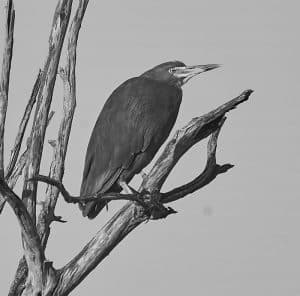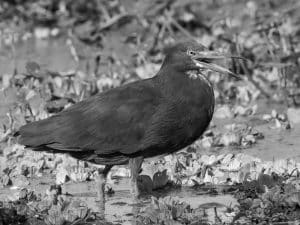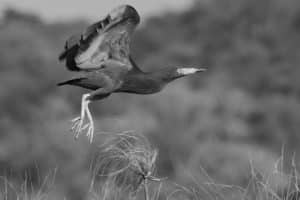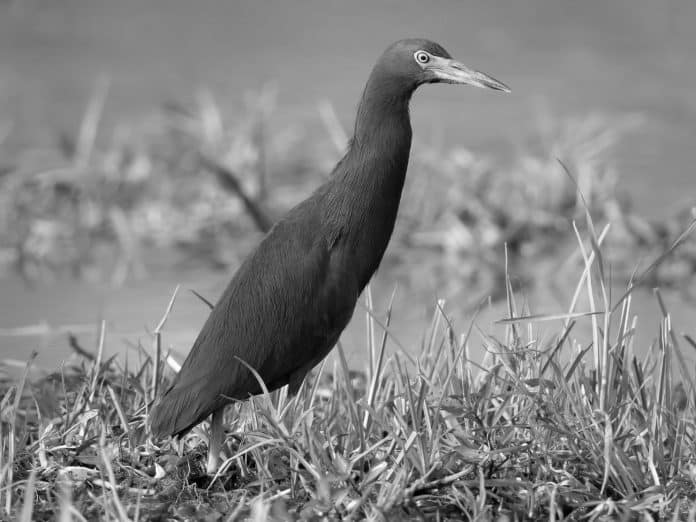Introduction to the Rufous-Bellied Heron
Welcome to the world of the Rufous-Bellied Heron, a fascinating and enigmatic bird species that inhabits the beautiful landscapes of Tanzania. The Rufous-Bellied Heron in Tanzania, scientifically known as Ardeola rufiventris, is a striking bird with a distinctive appearance and intriguing behavior. As we delve into the world of this magnificent avian creature, we will explore its habitat, distribution, ecological significance, behavior, breeding patterns, conservation efforts, challenges, and opportunities for birdwatching and ecotourism in Tanzania.

The Rufous-Bellied Heron is a medium-sized heron with a unique combination of rufous and grey plumage, making it a visually stunning sight in its natural environment. Its striking appearance and elusive nature have captured the imagination of bird enthusiasts and researchers alike. Found in various wetland habitats across Tanzania, this heron is a symbol of the country’s rich biodiversity and natural heritage. Its presence in the region underscores the importance of preserving and understanding the delicate ecosystems that support its existence.
Habitat and Distribution of the Rufous-Bellied Heron in Tanzania
The Rufous-Bellied Heron is primarily found in marshes, swamps, riverbanks, and other wetland areas throughout Tanzania. These diverse habitats provide the heron with ample opportunities for foraging, nesting, and raising its young. The heron’s distribution spans across different regions of Tanzania, including the wetlands of the Serengeti, the Selous Game Reserve, and the coastal areas along the Indian Ocean. The adaptability of the Rufous-Bellied Heron to various wetland ecosystems reflects its resilience and ability to thrive in different environmental conditions.
In addition to its presence in natural wetlands, the Rufous-Bellied Heron has also been observed in human-altered landscapes, such as rice paddies and agricultural fields near water bodies. This adaptability highlights the heron’s capacity to coexist with human activities while maintaining its reliance on wetland habitats for sustenance and reproduction. Understanding the specific habitat requirements and distribution patterns of the Rufous-Bellied Heron is crucial for developing effective conservation strategies and ensuring the long-term survival of this iconic species in Tanzania.
Ecological Significance of the Rufous-Bellied Heron
The Rufous-Bellied Heron plays a significant ecological role within the wetland ecosystems of Tanzania. As a top predator in its habitat, the heron helps regulate the population of small aquatic organisms, including fish, amphibians, and invertebrates. By preying on these species, the heron contributes to the balance of the food web and helps control the abundance of potential prey populations. This ecological role underscores the importance of the Rufous-Bellied Heron as a keystone species in wetland environments.
Furthermore, the presence of the Rufous-Bellied Heron serves as an indicator of wetland health and vitality. Its reliance on healthy, functioning wetland ecosystems highlights the interconnectedness of various species and the reliance of the heron on the availability of suitable prey and nesting sites. Monitoring the populations of Rufous-Bellied Herons can provide valuable insights into the overall ecological integrity of wetland habitats in Tanzania and serve as an early warning system for potential environmental disturbances and imbalances.
The conservation of the Rufous-Bellied Heron is not only important for the species itself but also for the preservation of the entire wetland ecosystem and the multitude of other species that depend on these vital habitats for their survival. Recognizing the ecological significance of the Rufous-Bellied Heron reinforces the need for concerted conservation efforts to safeguard its future and the integrity of Tanzania’s wetland ecosystems.
Behavior and Breeding Patterns

The behavior and breeding patterns of the Rufous-Bellied Heron offer a captivating glimpse into the intricate lives of these avian marvels. These herons are known for their stealthy foraging techniques, often standing motionless in shallow water as they patiently wait for prey to come within striking distance. Their slender build and sharp beaks enable them to swiftly capture fish, frogs, and other aquatic creatures with remarkable precision. The heron’s hunting prowess and solitary nature make it a fascinating subject for behavioral observation and study.
During the breeding season, Rufous-Bellied Herons engage in elaborate courtship displays, which involve aerial acrobatics, vocalizations, and intricate rituals to attract potential mates. These displays are a testament to the heron’s dedication to securing breeding partners and establishing territories within their wetland habitats. Once paired, the herons construct intricate nests in secluded areas near water, where they raise their offspring with attentive care and provision.
The breeding success of Rufous-Bellied Herons is closely tied to the availability of suitable breeding sites and the abundance of prey in their surrounding environment. Understanding the nuances of their behavior and breeding ecology is essential for implementing effective conservation measures that support their reproductive success and overall population health. By gaining insights into the behavior and breeding patterns of these herons, researchers and conservationists can develop targeted strategies to mitigate potential threats and enhance the prospects for their long-term sustainability.
Conservation Efforts for Rufous-Bellied Herons in Tanzania
In light of the ecological importance and cultural significance of the Rufous-Bellied Heron, conservation efforts have been underway to protect and preserve this iconic species in Tanzania. Collaborative initiatives involving government agencies, conservation organizations, local communities, and international partners have been instrumental in raising awareness about the conservation needs of the Rufous-Bellied Heron and implementing practical measures to safeguard its habitat and populations.
One of the key conservation strategies for Rufous-Bellied Herons in Tanzania focuses on habitat preservation and restoration. By identifying critical wetland areas and establishing protected zones, conservationists aim to secure key habitats for the herons and mitigate the impacts of habitat loss and degradation. Additionally, efforts to engage local communities in wetland conservation and sustainable resource management have contributed to the establishment of community-based conservation programs that align the interests of human communities with those of the Rufous-Bellied Heron and its wetland habitats.
The conservation of Rufous-Bellied Herons also involves research and monitoring initiatives aimed at gathering essential data on population trends, habitat use, and ecological dynamics. By employing advanced tracking technologies, field surveys, and remote sensing techniques, researchers can gain a comprehensive understanding of the heron’s spatial ecology and behavioral patterns, informing targeted conservation interventions and adaptive management strategies. These research efforts are crucial for informing evidence-based conservation actions and ensuring the effective protection of Rufous-Bellied Herons in Tanzania.
Challenges and Threats Facing the Rufous-Bellied Heron
While conservation efforts have made significant strides in protecting the Rufous-Bellied Heron, the species continues to face a range of challenges and threats that jeopardize its long-term survival in Tanzania. Habitat loss and degradation due to human activities, such as deforestation, urban development, and agricultural expansion, pose a significant threat to the integrity of wetland ecosystems that are vital for the heron’s existence. The conversion of wetlands for industrial and agricultural purposes further exacerbates the fragmentation and loss of critical habitat for the herons.
In addition to habitat degradation, the Rufous-Bellied Heron is vulnerable to the impacts of pollution, climate change, and invasive species. Water pollution from agricultural runoff, industrial discharge, and urban waste can degrade the quality of wetland habitats, affecting the availability of clean water and prey for the herons. Furthermore, the altered precipitation patterns and temperature regimes associated with climate change can disrupt the seasonal dynamics of wetland ecosystems, potentially impacting the reproductive success and foraging opportunities for Rufous-Bellied Herons.
The introduction of invasive species, such as predatory fish and non-native plants, can also disrupt the balance of wetland ecosystems and compete with native species for resources. These challenges collectively pose a complex and interconnected set of threats to the Rufous-Bellied Heron and necessitate comprehensive conservation approaches that address both direct and indirect impacts on the species and its habitats.
Opportunities for Birdwatching and Ecotourism
Tanzania’s diverse and captivating natural landscapes provide a unique opportunity for birdwatching enthusiasts and ecotourists to experience the wonders of the Rufous-Bellied Heron in its natural environment. The country’s extensive network of national parks, game reserves, and wetland areas offers prime locations for observing and photographing these majestic herons in their habitats. The allure of encountering the Rufous-Bellied Heron amidst the scenic beauty of Tanzania’s wetlands draws visitors from around the world, contributing to the country’s ecotourism sector and promoting appreciation for its rich avian diversity.
In addition to birdwatching excursions, ecotourism activities centered around the Rufous-Bellied Heron provide opportunities for educational experiences and immersive encounters with local conservation efforts. Guided tours, interpretive walks, and community-led ecotourism initiatives offer visitors the chance to learn about the heron’s ecology, conservation challenges, and the role of local communities in preserving its habitat. By engaging in responsible ecotourism practices, visitors can support conservation initiatives and contribute to the sustainable management of the Rufous-Bellied Heron’s natural environment.
The promotion of birdwatching and ecotourism opportunities in Tanzania not only generates economic benefits for local communities but also fosters a sense of stewardship and appreciation for the country’s natural heritage. By showcasing the beauty and importance of the Rufous-Bellied Heron, Tanzania can inspire a global audience to value and protect its wetland ecosystems, ensuring the continued enjoyment of this avian spectacle for generations to come.
Research and Monitoring of Rufous-Bellied Herons in Tanzania
Research and monitoring efforts play a pivotal role in advancing our understanding of Rufous-Bellied Herons and guiding effective conservation actions in Tanzania. Through systematic surveys, field studies, and ecological assessments, researchers can gather critical data on the distribution, abundance, and ecological requirements of the herons, informing evidence-based conservation strategies and adaptive management approaches. By utilizing innovative technologies, such as satellite telemetry, GPS tracking, and remote sensing, researchers can elucidate the spatial movements and habitat preferences of Rufous-Bellied Herons, identifying key areas for conservation prioritization.

Long-term monitoring programs offer valuable insights into population trends, demographic parameters, and the responses of Rufous-Bellied Herons to environmental changes. By establishing standardized monitoring protocols and citizen science initiatives, conservation practitioners can engage a broad network of stakeholders in data collection and contribute to the collective understanding of the heron’s status and conservation needs. This collaborative approach fosters a sense of ownership and participation among local communities, researchers, and conservation organizations, enhancing the effectiveness of conservation actions and promoting the sustainable coexistence of humans and herons in Tanzania.
Furthermore, research endeavors focused on the ecological interactions, behavioral ecology, and genetic diversity of Rufous-Bellied Herons contribute to the broader scientific knowledge of wetland ecosystems and avian conservation. By integrating interdisciplinary approaches and fostering partnerships between academic institutions, governmental agencies, and non-governmental organizations, Tanzania can position itself as a hub for innovative research and conservation excellence, setting a precedent for the sustainable management of its natural resources and the protection of its iconic bird species.
Conclusion and Call to Action
In conclusion, the Rufous-Bellied Heron holds a special place in the ecological tapestry of Tanzania, symbolizing the intrinsic value of the country’s wetland habitats and the interconnectedness of its natural heritage. As we marvel at the beauty and significance of these enigmatic herons, it becomes clear that their conservation is not just a matter of safeguarding a single species, but a testament to our commitment to preserving the integrity and resilience of Tanzania’s wetland ecosystems for future generations.
To ensure the enduring presence of Rufous-Bellied Herons in Tanzania, we must collectively embrace the call to action for their protection and conservation. This entails supporting community-led initiatives, advocating for sustainable resource management, and promoting responsible ecotourism practices that align with the long-term well-being of the herons and their habitats. By championing the cause of the Rufous-Bellied Heron, we can inspire a legacy of environmental stewardship and ensure that these remarkable birds continue to grace Tanzania’s wetlands with their presence for years to come.
As we embark on this journey of conservation and appreciation for the Rufous-Bellied Heron, let us stand as guardians of its wetland homes, ambassadors of its ecological significance, and advocates for the sustainable coexistence of humans and herons in Tanzania. Together, we can uphold the legacy of the Rufous-Bellied Heron and nurture a future where its graceful flight and resplendent plumage remain a testament to the enduring beauty of Tanzania’s natural world. Join us in our commitment to safeguard the Rufous-Bellied Heron and the wetland ecosystems it calls home, for the benefit of all who cherish the wonders of nature.


































